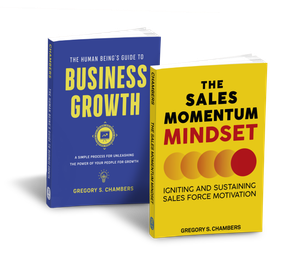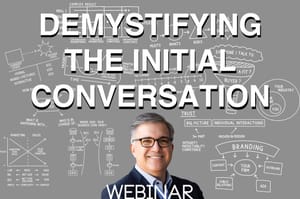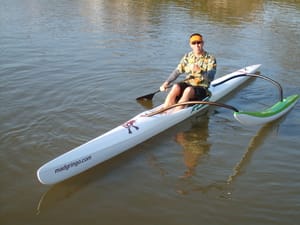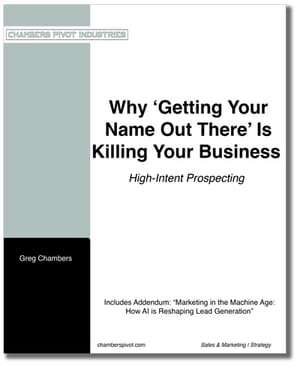Right FIT Newsletter #169 - In the Moment, MVP vs Weak Link, Machine Learning

GREG'S RIGHT FIT NEWSLETTER #169
Quick notes to help you get more sales and marketing done in less time. . . next week.
In this issue:
- Techniques for FIT
- Being Human
- Random Stuff
Techniques for FIT
- Stick to the truth when confronted. It may be uncomfortable in the moment, but it's much easier in the long run.
- Experience a successful outcome in your head before you start. The clearer and more emotional your vision, the easier it is to get there.
- Loving to do something and making it your job shouldn't be one in the same. However if your job allows you to use your passion, that's a key ingredient of the recipe for growth.
- Fixing things means you're not improving things. Growth requires you to spend at least half your time innovating.
Being Human - MVP vs Weakest Link Mindset ------------------------------------------------------------
An excerpt from "The Human Being's Guide to Business Growth." To get your copy, reach out.

MVP vs. Weakest Link Mindset
As you apply the concepts in The Human Being’s Guide to Business Growth, you’ll run into one of two mindsets. Specifically, people are either inclined to believe in Most Valuable Players (MVPs) or they think that you’re only as strong as your weakest link, see Figure 1.3.
The MVP mindset is best described as the belief that one person can have an outsized effect on your organization. Let me give you an example. In the world of sports, there are endeavors that are MVP oriented and others that are weakest link oriented. The 2011–2017’s NBA finals showed us that the game of basketball is MVP oriented. As a team owner, you can bring in a LeBron James and he can almost single-handedly get you to the finals, and most of the time, win the championship. There are only five players on the floor at once, and one player can have an outsized impact. That’s a sport with an MVP orientation.
On the other hand, the 2016 MLB World Series suggests that any single superstar player will only have so much impact. The Los Angeles Dodgers and San Francisco Giants may have had the top pitchers in the game, but the Chicago Cubs were tougher top-to-bottom, night after night. Especially the bottom of their batting order. They had a better chance at winning because baseball puts nine players on the field and plays 162 games in six months. It makes sense that you’re only as good as your weakest link.
That’s a weakest-link orientation.

Figure 1.3 MVP vs. Weakest link mindset
As you roll out The Human Being’s Guide to Business Growth to your leadership, you’re going to hear some of them buy-in right away. Especially the leadership of your marketing department. They tend to sell one message to many recipients, so they’re biased to weakest link think- ing. Contrast that with your sales leadership. They have been exposed to incredible producers before, the kind of sales talent that can carry an entire company. They’ll be biased toward an MVP mindset.
How will that impact your rollout? The MVP oriented will hear it like, “Unleashing the power of everyone in the company? Well, maybe... I’ll say almost everyone.” The weakest link oriented will hear it like “The power of everyone? Well, of course. That’s what I’ve been saying.”
You’d think that means the weakest-link-oriented people are easier to work with on this idea, but that’s not necessarily true. The MVPs have a point about not everyone being able to grow a business. It’s true and we’ll address that in Chapters 7 and 8. Sometimes it’s easier to find a new person to put on the bus.
On the other hand, the weakest links are optimistic enough that they can’t imagine anyone pushing back or not participating at some level. We’ll need to prepare them for dealing with the “I don’t care, selling’s not my job” people of the world and that will happen in Chapters 5 and 6.
There is no right or wrong mindset and we move fluidly from one to the other as it suits our needs. It’s a spectrum ranging from “we need everyone” to “I can do this by myself.”
Random Stuff
The machines are training us

We're wandering through NYC's fine mass transit system, and find ourselves in its largest subway station, 64 million riders annually. As tourists trying to look like a locals, we walk fast, heads down. I have my new Airpods in, so no wires are between the soothing voice of Siri and my ear canals as she helps me navigate my way to the right corner of this massive sprawl.
Once we've surfaced, I'm a little disoriented and my device seems to have disconnected from the grid. Desperate to get some direction on which direction I need to go, I set off boldly across the street. No luck. I stop and try moving my phone closer to wherever the signal is. (trying to avoid getting my face recognized by those ubiquitous LinkNYC kiosks Mark Hurst has been warning me about) As my lower lip curls over the top of my mouth in thought, I notice my bride looking at me, clearly annoyed.
"I'm trying to get a signal. They lost me on the grid," I say and wave my phone a little higher in the air.
"Why don't we just use our brains and figure it out," she says.
At the moment, I dismiss her suggestion, but a week later I realize she has a point.
Someone needs to unplug.
Then I remind myself that if I unplug I'd still think "Saying Goodbye" by J.S. Ondara is sung by a woman.
There are some benefits to being assimilated.
If you need to set up a time to visit, follow this link:
https://calendly.com/chamberspivot/





